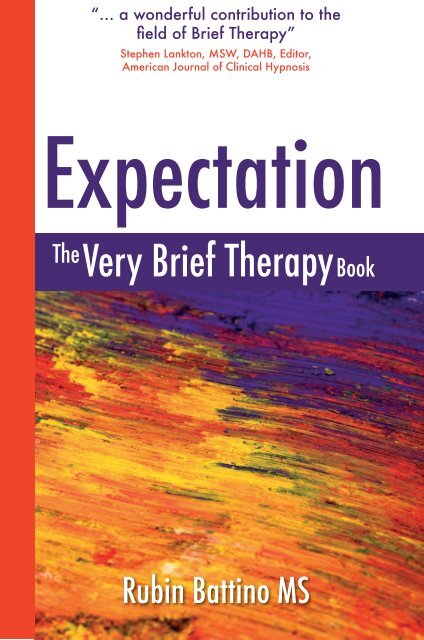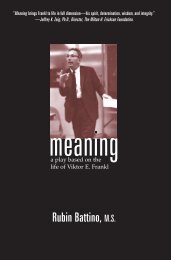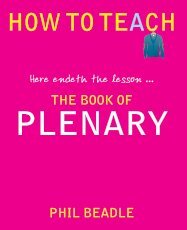Expectation
Look Inside - Crown House Publishing.
Look Inside - Crown House Publishing.
Create successful ePaper yourself
Turn your PDF publications into a flip-book with our unique Google optimized e-Paper software.
“… a wonderful contribution to thefield of Brief Therapy”Stephen Lankton, MSW, DAHB, Editor,American Journal of Clinical Hypnosis<strong>Expectation</strong>TheVery Brief Therapy BookRubin Battino MS
<strong>Expectation</strong>The Very Brief Therapy BookRubin BattinoMS, Mental Health CounselingAdjunct Professor, Department of Human Services (Counseling)Wright State University
First published byCrown House Publishing LtdCrown Buildings, Bancyfelin, Carmarthen, Wales, SA33 5ND, UKwww.crownhouse.co.ukandCrown House Publishing Company LLC4 Berkeley Street, 1st Floor, Norwalk, CT 06850, USAwww.CHPUS.com© Rubin Battino 2006The right of Rubin Battino to be identified as the author of this workhas been asserted by him in accordance with the Copyright, Designsand Patents Act 1988.All rights reserved. Except as permitted under current legislation no part of thiswork may be photocopied, stored in a retrieval system, published, performed inpublic, adapted, broadcast, transmitted, recorded or reproduced in any form or byany means, without the prior permission of the copyright owners. Enquiriesshould be addressed to Crown House Publishing Limited.British Library of Cataloguing-in-Publication DataA catalogue entry for this book is available from the British Library.10-digit ISBN 184590028613-digit ISBN 978-184590028-1LCCN 2006923155Printed and bound in the UK byCromwell PressTrowbridgeWiltshire
ContentsForeword: Long Days Journey into Light by Scott D. Miller, PhD ............. ixIntroduction .................................................................................................... xvChapter 1 Introduction to Very Brief Therapy.................................. 11.1 Introduction ................................................................ 11.2 The Great Psychotherapy Debate ............................. 31.2.1 Five Components of the Medical Model...... 31.3 The Heart and Soul of Change .................................. 81.4 Duncan, Miller and Sparks’s “Heroic Client”....... 121.4.1 The Outcome Rating Scale .......................... 151.4.2 The Session Rating Scale ............................. 151.5 Moshe Talmon’s Single Session Therapy(SST) .......................................................................... 201.6 Some Concluding Comments.................................. 23Chapter 2 <strong>Expectation</strong> and As-If ....................................................... 252.1 Importance of <strong>Expectation</strong>, Motivationand As-If ..................................................................... 252.2 The Theory of Change .............................................. 272.3 The Power of As-If .................................................... 292.4 Reframing................................................................... 292.5 Summing Up.............................................................. 32Chapter 3 Rapport ................................................................................ 333.1 Importance of Rapport ............................................. 333.2 Rapport-building Skills ............................................ 353.2.1 Linguistic or Verbal Pacing ......................... 353.2.2 Physical or Postural Pacing ..........................36Chapter 4 Language for Very Brief Therapy ................................... 374.1 Hypnotic Language .................................................. 374.2 <strong>Expectation</strong>al Language—Suggestions,Implications and Presuppositions ......................... 46v
<strong>Expectation</strong>4.3 Torpedo Style Language .......................................... 494.4 Metaphoric Language .............................................. 504.5 Summing Up.............................................................. 51Chapter 5 Hypnosis and Very Brief Therapy ................................. 555.1 Rationale for Using Hypnosis ................................ 555.2 Metaphor and Hypnosis .......................................... 565.3 Hypnosis in Various Therapies ............................... 57Chapter 6 Solution-Oriented Approaches....................................... 596.1 The Work of de Shazer and Associates .................. 596.2 Miller and Duncan and Colleagues’Approaches ................................................................ 636.3 Berg and Dolan and Miller’s Wisdom.................... 636.4 Common Sense .......................................................... 65Chapter 7 Bill O’Hanlon’s Approaches............................................ 677.1 Inclusive Therapy...................................................... 677.2 Brief, Respectful Therapy......................................... 717.3 Hypnosis in O’Hanlon’s Work ............................... 74Chapter 8 Lucas Derks’s Social Panorama....................................... 758.1 Introduction ............................................................... 758.2 Some Examples of Social Panoramas ..................... 788.3 Summing Up ............................................................. 83Chapter 9 Erickson and Very Brief Therapy.................................... 859.1 Utilization Principle.................................................. 859.2 Practicality.................................................................. 879.3 Stories and Metaphors.............................................. 899.4 Tasks and Ordeals ..................................................... 91Chapter 10 Jay Haley and Ordeal Therapy........................................ 9310.1 What is Ordeal Therapy? ......................................... 9310.2 Haley’s Systematics of Ordeal Therapy................. 9410.3 Examples of Ordeals ................................................. 96vi
ContentsChapter 11 Ambiguous Function Assignments................................ 9911.1 Description of Ambiguous FunctionAssignments............................................................... 9911.2 Some Suggestions for AmbiguousFunction Assignments ........................................... 102Chapter 12 Burns’s Nature-Guided Therapy .................................. 10712.1 What is Nature-Guided Therapy? ........................ 10712.2 Some Ecotherapy Procedures andExamples .................................................................. 10912.3 Nature Heals ........................................................... 114Chapter 13 Metaphoric Approaches.................................................. 11513.1 Uses of Metaphor ................................................... 11513.2 Richard R. Kopp’s Metaphor Therapy ................ 11713.2.1 Client-generated Metaphors forImmediate Concerns ................................... 11813.2.2 Transforming the Early-memoryMetaphor ..................................................... 11913.3 Guided Metaphor ................................................... 120Chapter 14 Rossi’s Rapid Methods ................................................... 12314.1 Fail-safe Methods .................................................... 12314.2 Ideodynamic Methods(mostly D. B. Cheek) ............................................... 12814.3 Some Concluding Comments................................ 130Chapter 15 NLP Approaches .............................................................. 13315.1 The NLP Meta-model of Language ...................... 13315.1.1 Distortions .................................................... 13415.1.2 Generalizations............................................ 13515.1.3 Deletions ...................................................... 13615.2 The “Swish” Method .............................................. 13815.3 Time Line Therapy .................................................. 14015.4 V-K Dissociation ...................................................... 14215.5 Reframing the NLP Way ........................................ 14315.6 Changing Personal History.................................... 14415.7 Summing Up............................................................ 145vii
<strong>Expectation</strong>Chapter 16 Narrative Therapy ........................................................... 14716.1 Introduction ............................................................. 14716.2 Some Elements of Narrative Therapy .................. 14816.3 Summing Up............................................................ 152Chapter 17 Rituals and Ceremonies.................................................. 15517.1 Introduction ............................................................. 15517.2 Psychotherapeutic Uses of Ceremonies ............... 158Chapter 18 When All Else Fails ......................................................... 161Ask the Client .......................................................... 162Listen ........................................................................ 163Minimalism ...............................................................164Crystal Ball ............................................................... 164Metaphors................................................................. 165Ambiguous Function Assignments ...................... 165Look at Yourself From … ...................................... 165Provocative Therapy............................................... 166Refer/Consult.......................................................... 166Chapter 19 Brief Final Thoughts ....................................................... 16919.1 The Universal Very Brief TherapyIntervention (UVBTI) ............................................. 170References ....................................................................................................... 173Index ................................................................................................................ 183viii
IntroductionA number of years ago, I heard an impressive talk by the psychologistMoshe Talmon on single-session therapy. I even had theprivilege of spending some time chatting with him over a meal. Hisbook on the subject (1990) and the talk contain three startlingrevelations about the process of doing psychotherapy. Talmon didthe unusual thing of studying the records of the large healthmaintenance organization he worked for. His first discovery wasthat the most common number of sessions for the large number ofclients the psychotherapy staff saw was one. The second revelationwas that there was no apparent connection between the orientationof the therapist, i.e., the type of psychotherapy they used in theirpractice, or with a particular therapist. That is, the modal length oftherapy for every one of the therapists was a single session.Moreover, thirty per cent of the patients chose to come for only onesession in the period of one year. (I will be writing more later aboutthe research that shows that the therapist’s orientation has little todo with outcome.) The third revelation had to do with follow-upphone calls by neutral staff members. The patients were asked ifthey were satisfied with the therapy they received. Then they wereasked to tell the caller what it was that the therapist did that was sohelpful. Independently, the therapists were asked to consult theircase notes (this is six months to one year later) and to relate what itwas that they thought they did in the session that was helpful to theclient. Again, in the judgment of the therapist, what had they donethat was critical in helping the client? You may or may not besurprised to discover that there was essentially zero correlationbetween what the client said helped them and what the therapistthought was important! A reasonable conclusion from this is that itis the client’s expectations and attitude that are the importantelements of successful therapy.This brings me to the subject of this book. It is simply how I work asa very brief therapist. My hope is that you will learn some usefulways of working fast and effectively. By “very brief” I mean that Ixv
<strong>Expectation</strong>rarely see my clients more than one or two times—usually it is justonce. (They do know that I will see them as many times as theyfeel that meeting with me will be helpful.) I do get feedbacksporadically, and it has been uniformly positive. It is my expectationthat each session is the last one, and that generally one session is allthat is needed. Of course, working for myself, my sessions arealways open-ended and can last a long time. That is, there is notime constraint on a session. Given my expectation and belief in asingle session, it is natural that the client accepts this, and thatthe session is full of meaningful work for the client. My intakeform is quite simple, I do not do testing or diagnoses, and weget right down to work. As a related illustration, I recall somecomments the psychologist Joseph Barber made about workingwith clients who have migraines. In effect, he tells them that theirbody already knows how to stop the migraine because it invariablydoes so after some period of time. Since this is invariably thecase, the client must agree with this statement. Barber’s question(and suggestion) to the client is, “Since your body already knowshow to end the migraine, why wait one, two, or three daysto do this when you can actually do it in the next hour, oreven the next few minutes?” Change the frame and change theexpectation. So, throughout this book, the idea of “expectation” willbe prominently featured.Chapter 1 is not only an introduction to the book and theidea of doing very brief therapy, but it is also a summary ofsignificant research on this subject. In particular, the work of Miller,Duncan, Hubble and associates, and that of Wampold will behighlighted. What has emerged from their research is evidencesupporting what I cited above as Talmon’s “revelations”. In effect,the clients and their attitudes and expectations are the central keyto all psychotherapeutic work. I will be writing more about thislater, yet I must insert here the bit of wisdom some group leaderin my early training gave, “When all else fails, ask the clientwhat will work.” Perhaps, this should be done before “allelse fails”!In Chapter 2, I discuss the ideas of expectation as applied topsychotherapy, and also the power of As-If. Also covered are thetheory of change and reframing. The therapeutic alliance has beenwritten and spoken about as being central to change work, soxvi
IntroductionChapter 3 briefly covers rapport-building skills. That is, it is usefulif the client believes that you both exist in the world in somehowand somewhat similar ways.Being restricted to “talk” therapy by not being a physician meansthat the psychotherapist needs to rely on language to help a clientfind ways to change. Chapter 4, then, is a short introduction tolanguage usage for doing very brief therapy (NLP Meta-modelof language is discussed in Chapter 15). Since hypnosis can be apowerful adjunct to therapeutic work, Chapter 5 recounts the waysin which hypnosis can be used expectationally for change work.Recall that any procedure that asks a client to go “inside” involvessome level of trance.The solution-oriented approaches developed by Steve de Shazerand his associates are quite useful for rapid change work. The“miracle question” and its variants are effective. This is covered inChapter 6. Bill O’Hanlon’s approaches are discussed in Chapter 7,and they include his “brief, respectful approaches”, inclusivetherapy and hypnotic work.Derks’s Social Panorama work can be effective in interesting waysby incorporating the client’s images about their social environment.This is presented in Chapter 8. Milton H. Erickson was apioneer in the area of very brief therapy. His Utilization Principleis a guideline for involving who the client is in organizing asession. The client is central to a session, and it has been said ofErickson that he devised a new approach to fit each client. Chapter9 discusses Erickson’s methods of working briefly, although,if you study his cases you will find that he was flexible in thenumber of sessions for any given client. Erickson’s sessions werealso open-ended.Two approaches derived from Erickson’s work, and then extensivelydeveloped further, are “Ordeal Therapy” as practiced by JayHaley (Chapter 10), and “Ambiguous Function Assignments” assystematized by the Lanktons (Chapter 11). Burns has developedan approach that involves interaction with Nature, and which hecalls “Nature-Guided Therapy” or “Ecotherapy”. This is covered inChapter 12.xvii
<strong>Expectation</strong>Metaphoric approaches have been used in many ways by manypractitioners. Erickson was a master of metaphor. In addition todiscussing classical metaphoric work, Chapter 13 providesinformation on R. R. Kopp’s “Metaphor Therapy”, and Battino’s“Guided Metaphor”.Over the years, E. L. Rossi has developed a number of rapidmethods for doing therapy. He describes some of them as“fail-safe”, others as polarity approaches, and is a master onminimalism in working with a client. Rossi’s work is described inChapter 14.Neurolinguistic Programming (NLP) has been prolific indeveloping many ways of doing brief therapy. Some of thesemethods will be described in Chapter 15. “Narrative Therapy” asdeveloped by Epston and White has the client’s life story and theclient as central to change work. The principles and practice of theirwork is the subject of Chapter 16. Rituals and ceremonies arediscussed in Chapter 17.Finally, there are some “when all else fails” comments by way ofsummary in Chapter 18. At the core of the author’s way of doingvery brief therapy is his expectation that it is possible and practicaland learnable. Why not?xviii
Chapter 4Language for Very BriefTherapy4.1 Hypnotic LanguageSince I am oriented to the use of hypnosis in most of what I do, Inaturally tend to use hypnotic language forms in most everythingthat I do. The second edition of Ericksonian Approaches (Battino andSouth, 2005, pp. 65–144) contains a long and detailed chapter onhypnotic language forms. The interested reader should consult thisbook for a more comprehensive treatment than the brief one givenin this chapter. A shorter version is in Battino (2000, pp. 97–116) asapplied to language usage in guided imagery.A basic tenet in the kind of hypnotic language I use is that oftenattributed to Milton H. Erickson, and that is the precise use of vaguelanguage. This means the careful and conscious choice of theexact word(s) for a particular purpose. Since the work that mosttherapists do is talking therapy, then the spoken word is themedium of change. This, of course, is not to ignore the interpersonalaffective components of any session—many of which werediscussed in the previous chapter. But, words are of the essence.In short, this reduces to: “What do you say after the client sayssomething?” What you say has to be related and connected to whatthe client has said. If you are thinking about what you are going tosay and not listening to the client, then you are not doing your job.It is not exactly counter-punching, yet there needs to be sufficientconnection that the client knows you are listening to them. Inthis sense, the client is actually leading what is going on in thesession. After all, the client is central, and not your theory of how todo therapy.Most communication is in what linguists call surface structures, thatis, sentences that only contain partial meaning—information is37
<strong>Expectation</strong>omitted. If the client says, “I am really sad,” this conveys only partof the meaning. Sad about whom or what and in what way and towhat depth? The deep structure contains the full linguistic meaningthat it is possible to state. This might be something like, “I am very,very sad about my friend Jane who died yesterday—we had beenclose friends for many years, and this has hit me quite hard.” Pleasenote that although this sentence conveys much more about theclient’s emotional state, it is only a verbal communication thatcould be more complete, and it does not contain all of the internalmemories and feelings associated with Jane. The word “sad” canhave many interpretations, and your understanding of sadnessmay be quite different from that of your client. All of this maygive the appearance of making communication impossible. It isdifficult. Good communication skills can be learned. One helpful thingto keep in mind is that the meaning of any communication is theresponse that you get. So, paying attention to your client’s responsesis of great importance. Of course, when you are in doubt, you canalways ask!In terms of impact, some words are “more equal” than others.This section presents classes of such words. (Much is owed toNLP for this organization. Also, see Section 15.1 on the NLPMeta-model.)A. NOMINALIZATIONWhen a verb or “action” word is converted into a noun or “static”word, this is a nominalization. Consider the difference between “Iam depressed” or “I am in depression” versus “I wonder what isdepressing me” Nominalizations seem to be cast in concrete, andwhen you think of yourself in nominalizations the situationappears hopeless. Denominalization involves converting a noun intoa verb and opens the possibility of change.B. UNSPECIFIED VERBSNo verb is completely specified in terms of an action. There are particularvague verbs that are useful with clients. Some of these are:38
Language for Very Brief Therapyknow, learn, understand, feel, change, wonder, do, think and fix.The listener fills in the specifics. Some examples are: “Change iseasier to do than you think”; “Your body knows just how todo that.”An unspecified referential index is a word such as: that, how,learn, know, body etc. That is, these words do not have a specificreference. A good example is the word “it” as in, “It really will help,will it not?”C. CAUSAL CONNECTIONSThese constructions exist in compound sentences where a connectionis implied or stated between one thing and another. There arethree levels of connection. The weakest is using the word “and” asin: “You are paying attention to your breathing, and becoming evenmore comfortable.” The next strongest linkage uses words relatedto time such as: while, during, as, when and soon. “As you payattention to your breathing, you are becoming more comfortable.”The strongest level of causal connection uses real causal words suchas: makes, causes, forces and requires. “As your breathing slows, itmakes you calmer. Start these causal connections with somethingthat is already going on such as sitting, blinking or breathing, andthen connect that to another condition.D. MIND-READINGThis is a form of pacing and leading that involves some guessworkbased on reading body language and intense conscious listening,for example, “I wonder what you are hearing/feeling/saying toyourself now.”E. LOST PERFORMATIVEIn this speech pattern evaluative statements are made, but it is notknown who makes the statement. “It” is the favorite generalization.“It’s not important just how fast you relax.” “It is good, isn’t it?”39
Chapter 12Burns’s Nature-GuidedTherapy12.1 What is Nature-Guided Therapy?In my many years of experience in working with people who havelife-challenging diseases, there appear to be some commonresponses when they are confronted with the diagnosis, and areforced by that diagnosis to re-evaluate their lives. The diagnosisgenerally implies a shorter life span. In addition to all of the decisionsthat need to be made about medical treatments and the practicalmatters of finance and jobs, there arise the existential questionsabout the meaning and goals of life. If the medical prognosis is justseveral more years of life, then how should you live out yourremaining time? What are the things that are really important? It isnot the new car, the promotion, or serving on some committee.Invariably, I have found, there are two things that stand out for aperson at that time of setting priorities. The first is people and relationships,loving and being loved, touching and being touched,being with loved ones, and sharing in their lives. Life, apparently, iswith people, in the humanity of contacts and relationships. Wemight guess that a large part of this is that when a person is verysick that they regress to childhood states seeking the comfort ofparental love and care. You just cannot survive such catastrophictimes alone, without others.The second thing that assumes great importance is contact withNature, with trees and flowers and sky and grass and clouds andwoodlands and prairies and mountains and flowing water and theocean. This may, perhaps, be the most primitive of our instincts—returning to the earth in which we are rooted. Beds and chairs needto be sited so that the person can look outside, at least be in visualcontact with the world around them. In a hospice facility I know of,every room has a large window looking out on a bird feeder and107
<strong>Expectation</strong>shrubs and trees. There is also a duck pond nearby, and ducks andgeese freely wander the grounds. When possible, if the patient orfamily request it, the patient is bundled up in a bed or a wheelchairand taken outside for a while. Nature is important. There have evenbeen studies showing that patients in hospital rooms that haveviews of nature appear to heal faster (Jerstad and Stelzer, 1973;Lowry, 1974; Ulrich, 1984).George W. Burns (1998) in his book entitled Nature-Guided Therapy:Brief Integrative Strategies for Health and Well-being has written abouthow to use contact with Nature in psychotherapy. He also callsthis approach ecotherapy or ecopsychotherapy. He writes about histerminology as follows (p. 20):In some ways the term nature-guided therapy expresses well whatthis approach is about. It defines nature as an initiator of health,healing, and well-being. By health I mean a state of physical wellness.… Healing is the process of rectifying an imbalance of thestate of health. It is about fixing a problem or resolving a disturbanceto our normal state of equilibrium. Well-being I define as abroader concept than either health or healing. It takes into accountthe emotional, relationship, and spiritual needs of the humanspecies. Well-being thus includes a state of physical health as wellas a mental and emotional state of consonance. Well-being isattained when a person is experiencing an inner state of wellness,exists in a healthy environment, and experiences a harmoniousconnection with that ecology. … The term nature-guided alsoincludes a sense of gentleness. …Although Burns prefers the term ecopsychotherapy, throughout histext he also uses the shorter term ecotherapy. He states (p. 135):The basic premise of ecotherapy is simple: Contact with the naturalenvironment can and does bring about changes at cognitive,behavioral, affective, and physical levels. Simple exposure tonatural stimuli can result in rapid change.In his introductory chapter, he lists ten characteristics of ecopsychotherapy:(1) effective; (2) brief; (3) solution oriented; (4) clientfocused; (5) pragmatic; (6) wellness based; (7) motivation enhancing;(8) encouraging of choice; (9) empowering; and (10) enjoyable.108
“ Rubin Battino has written a book that once again meetsthe superb standards of his previous works.Challenging preconceptions that therapy is aprolonged endeavour, <strong>Expectation</strong> is insightful andthought provoking and is a valuable reference manualfor those seeking a solid grounding in very briefapproaches to therapy. Rubin clearly explains hiseclectic and pragmatic approach, one that has beendrawn from a number of sources that allow him tocomplete the entire process of therapy in only one ortwo sessions.Another must have book from this respected authorand therapist.”Peter Mabbutt FBSCH, FBAMH, Director of Studies,London College of Clinical Hypnosis“ <strong>Expectation</strong> is a delightful compendium of dozensof interventions taken from a variety of currentapproaches to brief therapy. It is designed tofamiliarize therapists with skill sets which can helpthem work effectively and briefly. It is a wonderfulcontribution to the field of Brief Therapy”Stephen Lankton, MSW, DAHB,Editor, American Journal of Clinical HypnosisISBN 184590028-6ISBN ISBN 978-184590028-1184590028-69 0 0 0 0Crown House Publishing Limitedwww.crownhouse.co.uk9 781 845 900281
















